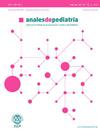在健康的儿童中补充维生素D
IF 2.1
4区 医学
Q2 PEDIATRICS
引用次数: 0
摘要
目的回顾目前关于无危险因素的健康儿童普遍补充维生素D疗效的科学证据,并对主要临床实践指南中提供的建议提出更新的修改意见。方法通过在PubMed中检索过去15年以英语或西班牙语发表的文章,使用以下MeSH检索词(维生素D)和(补充剂)进行文献检索。检索得到2133篇文章,其中22篇被选中。结果在1岁以下无危险因素的婴儿中,400iu /d可改善血清钙化二醇水平,但大多数研究未发现双能x线吸收测定法评估的钙化二醇与改善骨骼健康的关系。对于1岁以上且钙化二醇水平低于35 ng/mL的儿童,每天补充400至800 IU维生素D可降低呼吸道感染的风险。在儿科人群中,仍然没有证据表明补充维生素D既可以降低其他感染的风险或严重程度,也可以提供任何其他临床显着的骨骼外益处。结论根据主要的临床实践指南,对于1岁以下的母乳喂养婴儿或通过婴儿配方奶粉未达到推荐每日摄入量的婴儿,建议补充400 IU/天的维生素D。对于1岁以上的儿童,应个体化补充。本文章由计算机程序翻译,如有差异,请以英文原文为准。
Suplementación con vitamina D en población pediátrica sana
Objective
To review the current scientific evidence on the efficacy of universal vitamin D supplementation in healthy children with no risk factors and to propose updated modifications to the recommendations provided in the main clinical practice guidelines.
Methods
Scoping review through a literature search conducted in PubMed for articles published in English or Spanish in the past 15 years using the following MeSH search terms: (vitamin D) AND (supplementation). The search yielded 2133 articles, of which 22 were selected.
Results
In infants aged less than 1 year without risk factors, administration of 400 IU/day improves serum levels of calcifediol, but most studies have not found an association with improved bone health assessed by dual-energy X-ray absorptiometry. In children aged more than 1 year with calcifediol levels of less than 35 ng/mL, supplementation with 400 to 800 IU/day of vitamin D decreases the risk of respiratory infection. There is still no evidence in the pediatric population that vitamin D supplementation either decreases the risk or severity of other infections or offers any other clinically significant extraskeletal benefits.
Conclusion
Based on the main clinical practice guidelines, supplementation with vitamin D at a dose of 400 IU/day is recommended for breastfed infants aged less than 1 year or infants who do not achieve the recommended daily intake through infant formula. In children aged more than 1 year, supplementation should be individualized.
求助全文
通过发布文献求助,成功后即可免费获取论文全文。
去求助
来源期刊

Anales de pediatria
医学-小儿科
CiteScore
2.10
自引率
4.80%
发文量
155
审稿时长
44 days
期刊介绍:
La Asociación Española de Pediatría tiene como uno de sus objetivos principales la difusión de información científica rigurosa y actualizada sobre las distintas áreas de la pediatría. Anales de Pediatría es el Órgano de Expresión Científica de la Asociación y constituye el vehículo a través del cual se comunican los asociados. Publica trabajos originales sobre investigación clínica en pediatría procedentes de España y países latinoamericanos, así como artículos de revisión elaborados por los mejores profesionales de cada especialidad, las comunicaciones del congreso anual y los libros de actas de la Asociación, y guías de actuación elaboradas por las diferentes Sociedades/Secciones Especializadas integradas en la Asociación Española de Pediatría.
 求助内容:
求助内容: 应助结果提醒方式:
应助结果提醒方式:


